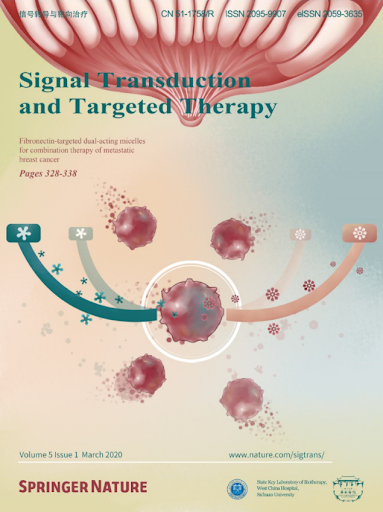Exosomal transfer of pro-pyroptotic miR-216a-5p exacerbates anthracycline cardiotoxicity through breast cancer-heart pathological crosstalk.
IF 40.8
1区 医学
Q1 BIOCHEMISTRY & MOLECULAR BIOLOGY
引用次数: 0
Abstract
Doxorubicin (DOX) is the most effective chemotherapeutic for breast cancer, but it is usually associated with severe cardiotoxicity. Further investigation to alleviate its side effects is essential. The present study investigated the mechanism of the cross-organ communication between tumors and the heart and potential intervention targets. Morphological bubble-like protrusions were observed in both adult murine ventricular cardiomyocytes (AMVCs) and human induced pluripotent stem cell-derived cardiomyocytes (hiPSC-CMs) cocultured with breast cancer cells (BCCs), along with elevated expression of pyroptosis-related proteins. Exosomes (EXOs) from DOX-treated BCCs aggravated DOX-induced cardiotoxicity (DOXIC) in an orthotopic mouse model of breast cancer. Blocking miRNAs by knocking down Rab27a or inhibiting the release of EXOs in cancer tissue by Dicer enzyme knockout attenuated this additional injury effect. Exosomal miRNA sequencing revealed that miR-216a-5p is especially upregulated in EXOs from DOX-induced BCCs. Mechanistically, miR-216a-5p was upregulated by enhanced transcription mediated by DOX-induced AMP-dependent transcription factor 3 (ATF3) and packaged into EXOs by splicing factor 3b subunit 4 (SF3B4) in BCCs. Itchy E3 ubiquitin-protein ligase (ITCH) was identified as a novel downstream target mRNA of miR-216a-5p. ITCH negatively mediated thioredoxin-interacting protein (TXNIP) ubiquitination to activate the NOD-, LRR- and pyrin domain-containing protein 3 (NLRP3) inflammasome pathway, ultimately leading to cardiomyocyte pyroptosis. Our findings revealed novel cross-organ pathogenic communication between breast cancer and the heart through the exosomal miR-216a-5p-mediated ITCH/TXNIP/NLRP3 pathway, which drives cardiomyocyte pyroptosis. These findings suggest that targeting myocardial miR-216a-5p or blocking harmful EXOs from breast cancer is a potential therapeutic strategy for alleviating DOXIC.前焦亡miR-216a-5p的外泌体转移通过乳腺癌-心脏病理串扰加剧了蒽环类药物的心脏毒性。
阿霉素(DOX)是治疗乳腺癌最有效的化疗药物,但它通常伴有严重的心脏毒性。进一步的研究以减轻其副作用是必要的。本研究旨在探讨肿瘤与心脏的跨器官通讯机制及可能的干预靶点。在成年小鼠心室心肌细胞(AMVCs)和人诱导多能干细胞来源的心肌细胞(hiPSC-CMs)与乳腺癌细胞(BCCs)共培养中均观察到形态学上的泡样突起,并伴有焦热相关蛋白的表达升高。在原位乳腺癌小鼠模型中,dox处理的bcc外泌体(EXOs)加重了dox诱导的心脏毒性(DOXIC)。通过敲除Rab27a或通过敲除Dicer酶抑制癌组织中exo的释放来阻断mirna,可以减弱这种额外的损伤效应。外泌体miRNA测序显示,在dox诱导的bcc的exo中,miR-216a-5p的表达尤其上调。在机制上,miR-216a-5p通过dox诱导的amp依赖性转录因子3 (ATF3)介导的转录增强而上调,并在bcc中通过剪接因子3b亚基4 (SF3B4)包装到exo中。瘙痒E3泛素蛋白连接酶(ITCH)被鉴定为miR-216a-5p的一个新的下游靶标mRNA。ITCH负介导的硫氧还蛋白相互作用蛋白(TXNIP)泛素化激活NOD-、LRR-和pyrin结构域蛋白3 (NLRP3)炎症小体途径,最终导致心肌细胞焦亡。我们的研究结果揭示了乳腺癌和心脏之间通过外泌体mir -216a-5p介导的ITCH/TXNIP/NLRP3途径的新的跨器官致病性交流,该途径驱动心肌细胞焦亡。这些发现表明,靶向心肌miR-216a-5p或阻断乳腺癌的有害exo是缓解DOXIC的潜在治疗策略。
本文章由计算机程序翻译,如有差异,请以英文原文为准。
求助全文
约1分钟内获得全文
求助全文
来源期刊

Signal Transduction and Targeted Therapy
Biochemistry, Genetics and Molecular Biology-Genetics
CiteScore
44.50
自引率
1.50%
发文量
384
审稿时长
5 weeks
期刊介绍:
Signal Transduction and Targeted Therapy is an open access journal that focuses on timely publication of cutting-edge discoveries and advancements in basic science and clinical research related to signal transduction and targeted therapy.
Scope: The journal covers research on major human diseases, including, but not limited to:
Cancer,Cardiovascular diseases,Autoimmune diseases,Nervous system diseases.
 求助内容:
求助内容: 应助结果提醒方式:
应助结果提醒方式:


